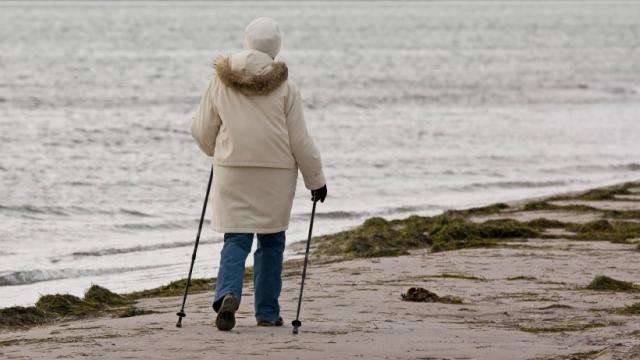Slower walking speed may predict future mobility problems
Being able to walk outside for several blocks at a leisurely pace plays an important role in living a vibrant, healthy life. Walking short distances allows you to get the physical activity you need, live independently, go shopping, access health care, and engage in a social life.

Older adults who got 45 minutes of moderate activity, such as brisk walking, per week were 80 percent more likely to improve or sustain high future function over two years compared with those doing less. Northwestern University
Health In Aging Blog July 23, 2019
Until now, there has been no ideal way for healthcare providers to measure walking ability, since it involves more than just walking speed. It also is about how you deal with your environment (such as uneven pavement) and demands on your attention (such as traffic, other pedestrians, and street crossings).
In a new study, researchers assessed ways to measure complex walking tasks to learn more about early, subtle changes in walking. Their study was published in the Journal of the American Geriatrics Society.
In their study, the researchers examined whether performance on complex walking tasks involving both physical and mental challenges predicted a higher risk for an inability to walk one-quarter mile (roughly four blocks). The researchers suspected that these complex walking tasks would be more strongly tied to the risk for mobility problems than simple walking.
The researchers studied information from the Health Aging and Body Composition (Health ABC) study, which enrolled black and white adults in Pittsburgh and Memphis from 1997 to 1998. The participants were 70 to 79 years old when they entered the study, and they had no difficulty walking a quarter mile or climbing 10 steps without resting.
In the study, participants walked on several different paths and were given several different challenges to measure their walking speed and their ability to cope with mental and physical tasks at the same time. Researchers then followed up with participants every six months to see if they had any difficulty walking one-quarter mile due to a health or physical problem.
Participants reported any mobility problems or disabilities every year at in-person visits. By the end of the eight-year follow-up, more than half of the participants had developed mobility disability, meaning they were unable to walk one-quarter mile. Almost 40 percent had developed chronic mobility disability that lasted at least two years.
Participants who reported having mobility disability were more likely to be female, have diabetes, be obese, have knee pain, and experience breathing difficulty. They also had more symptoms of depression.
The researchers concluded that slow walking speed under both usual-pace and complex conditions was associated with greater risk for developing mobility disability over the next eight years.
They also concluded that measuring your simple walking speed in the healthcare provider’s office may be enough for your provider to learn whether you might be at risk for future mobility problems.
Source Health In Aging Blog
via Science Daily
| References |
Associations of Usual Pace and Complex Task Gait Speeds With Incident Mobility Disability, Rosso AL, Metti AL, Faulkner K, Brach JS, Studenski SA, Redfern M, Rosano C. J Am Geriatr Soc. 2019 Jul 18. doi: 10.1111/jgs.16049.
| Further reading |
More random motor activity fluctuations predict incident frailty, disability, and mortality, Peng Li, Andrew S. P. Lim, Lei Gao, Chelsea Hu, Lei Yu, David A. Bennett, Aron S. Buchman, Kun Hu Science Translational Medicine. 30 Oct 2019. Vol. 11, Issue 516, eaax1977. DOI: 10.1126/scitranslmed.aax1977
Association of Neurocognitive and Physical Function With Gait Speed in Midlife, Rasmussen LJH, Caspi A, Ambler A, Broadbent JM, Cohen HJ, d’Arbeloff T, Elliott M, Hancox RJ, Harrington H, Hogan S, Houts R, Ireland D, Knodt AR, Meredith-Jones K, Morey MC, Morrison L, Poulton R, Ramrakha S, Richmond-Rakerd L, Sison ML, Sneddon K, Thomson WM, Hariri AR, Moffitt TE. JAMA Netw Open. 2019 Oct 2;2(10):e1913123. doi: 10.1001/jamanetworkopen.2019.13123. Full text
Decline in Fast Gait Speed as a Predictor of Disability in Older Adults, Artaud F, Singh-Manoux A, Dugravot A, Tzourio C, Elbaz A. J Am Geriatr Soc. 2015 Jun;63(6):1129-36. doi: 10.1111/jgs.13442. Epub 2015 Jun 11.
Gait Speed Predicts Incident Disability: A Pooled Analysis, Perera S, Patel KV, Rosano C, Rubin SM, Satterfield S, Harris T, Ensrud K, Orwoll E, Lee CG, Chandler JM, Newman AB, Cauley JA, Guralnik JM, Ferrucci L, Studenski SA. J Gerontol A Biol Sci Med Sci. 2016 Jan;71(1):63-71. doi: 10.1093/gerona/glv126. Epub 2015 Aug 22. Full text
Physical Activity Minimum Threshold Predicting Improved Function in Adults With Lower-Extremity Symptoms, Dunlop DD, Song J, Lee J, Gilbert AL, Semanik PA, Ehrlich-Jones L, Pellegrini CA, Pinto D, Ainsworth B, Chang RW. Arthritis Care Res (Hoboken). 2017 Apr;69(4):475-483. doi: 10.1002/acr.23181. Epub 2017 Feb 28. Erratum in: Arthritis Care Res (Hoboken). 2018 Jan;70(1):144. Full text
Also see
New Zealand study connects walking speed with brain health in 45-year-olds Duke University
Slower Walking Speed a Lifelong Indicator of Accelerated Aging Medscape Medical News
Stroke recovery clue from patient walking speed BBC News
